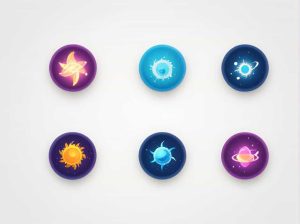Stars come in a wide range of sizes, brightness, and temperatures. Some stars shine brilliantly, while others are dim and cool. The dimmest stars in the universe are often the coolest, with temperatures much lower than those of larger, more luminous stars like our Sun.
But how cool can a star actually be? In this topic, we explore the temperature of the dimmest stars, their characteristics, and their place in the stellar classification system.
What Are the Dimmest Stars?
The dimmest stars are usually red dwarfs and brown dwarfs. These stars emit very little light and have relatively low surface temperatures compared to hotter stars like blue or white stars.
1. Red Dwarfs: The Coolest True Stars
- Red dwarfs are the smallest and dimmest stars that still undergo nuclear fusion in their cores.
- They belong to the M spectral class, with temperatures ranging from 2,500 to 3,800 K (Kelvin).
- Some of the coolest red dwarfs have surface temperatures as low as 2,000 K, making them much cooler than the Sun, which has a surface temperature of about 5,778 K.
2. Brown Dwarfs: The Failed Stars
- Brown dwarfs are sometimes called “failed stars” because they lack enough mass to sustain hydrogen fusion.
- They are even cooler than red dwarfs, with temperatures ranging from 300 to 2,500 K.
- The coolest brown dwarfs, such as those in the Y spectral class, can have temperatures below 500 K—cool enough that some could be mistaken for giant planets like Jupiter.
How Do Scientists Measure Star Temperature?
The temperature of a star is determined by its color and spectral classification. Astronomers use a system called the Hertzsprung-Russell (H-R) diagram to compare stars based on their temperature and brightness.
- Hot stars appear blue or white and have high surface temperatures (above 10,000 K).
- Cool stars appear red or orange and have low surface temperatures (below 4,000 K).
The dimmest stars, being the coolest, are found at the bottom right of the H-R diagram, where red dwarfs and brown dwarfs reside.
What Makes These Stars So Cool?
Several factors contribute to the low temperatures of dim stars:
1. Low Mass
- Red dwarfs and brown dwarfs have much less mass than the Sun.
- Less mass means less gravitational pressure, leading to lower temperatures in their cores.
2. Weak Nuclear Fusion
- Red dwarfs burn hydrogen slowly, producing less energy and keeping their temperatures low.
- Brown dwarfs do not sustain hydrogen fusion, making them even cooler.
3. Small Size
- The smaller surface area of dim stars means they emit less radiation, keeping their overall temperature low.
Examples of the Coolest and Dimmest Stars
1. Proxima Centauri
- The closest known red dwarf to Earth.
- Has a surface temperature of about 3,050 K.
- It is so dim that it cannot be seen with the naked eye.
2. TRAPPIST-1
- An ultra-cool red dwarf with a temperature of around 2,500 K.
- Known for hosting seven Earth-sized planets.
3. WISE 0855-0714
- A brown dwarf with an estimated temperature of 250 to 350 K.
- One of the coldest known brown dwarfs, with a temperature comparable to Earth’s polar regions.
Why Are Dimmest Stars Important?
1. Potential for Habitable Planets
- Many exoplanets orbit cool stars, and some may have conditions suitable for life.
- Red dwarfs are long-lived, giving planets more time to develop life.
2. Understanding Stellar Evolution
- Studying dim stars helps scientists learn about how stars form, age, and die.
3. The Search for Brown Dwarfs
- Brown dwarfs provide insights into the boundary between planets and stars.
The dimmest stars in the universe have low temperatures, often between 300 K and 3,800 K, depending on whether they are red dwarfs or brown dwarfs. These stars may be faint, but they play a significant role in astronomy. By studying these cool stars, scientists continue to unlock secrets about stellar evolution, planetary systems, and the potential for extraterrestrial life.



